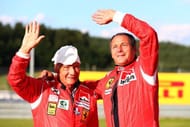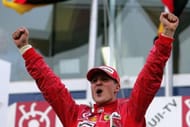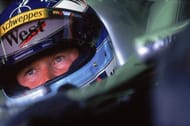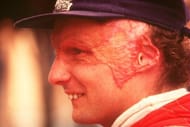Every sport deserves a hero. The more then, the merrier- isn’t it? And in the same breath, every sport also likes a great comeback.
Mohinder Amarnath in Indian Cricket pulled off comebacks that none thought were imaginable.
Tiger Woods, in Golf, is still an enigma, despite having been in the woods for a while.
But being there is one thing and returning quite literally from the dead or very nearly the dead (read risky) is something not many are able to pull off, right?
Monica Seles, despite being stabbed in the back by a die-hard Steffie Graff fan returned to the place where she belonged: the tennis court.
So what about Formula One then?
Do we have some stories amid us beside the one man whose 2019 return is expected to put the grid on fire once again: Robert Kubica?
Therefore, let’s explore the story of 5 of the greatest comebacks in the history of Formula 1.
Gerhard Berger

The Wörgl-born Berger is among the finest racers to have gotten behind an F1 car from Austria.
Best remembered for being a determined and focused driver, someone who spent 14 long years in the sport, Gerhard Berger wasn’t able to win a world championship even as he has to his credit 10 race wins and 21 fastest laps.
Yet, there’s a feat in Berger’s grasp that none can ever take away.
Interestingly, Berger’s greatest moment in life, that of defeating death, came off a circuit, albeit after just having completed his maiden year in F1 with ATS Racing.
In the winter of 1984, Berger, in a bid to avoid colliding with a car that was pulling out of a petrol station, spun off the road, and nearly ended up losing his life having landed halfway into a river, not before being thrown out of his car’s window.
A broken neck and an elaborate surgery later, Berger managed to compete with mighty bravery in the 1985 season and in the season-opener at Rio, went as high as seventh in the Grand Prix before a suspension failure ended his race.
Michael Schumacher

One remembers Schumi as one should for the multiple world titles.
One also regards Schumi for surpassing the barriers in a sport that most saw as being unsurpassable.
But none would be able to forget the tectonic events of the 1999 British Grand Prix, an event where not only did Michael Schumacher’s world title hopes took a big hit but because the ‘Kaiser’ of Grand Prix racing hurt himself a bit too badly.
Driving around the Stowe corner, Schumacher suffered a rear brake failure, a sudden incident that sent him mid-air at a speed of 160 km/h.
A broken tibia and fibula on his right leg caused Schumi to sit out for six races. Eventually, Mika Salo would take his place at Ferrari.
Finally, when Michael returned, and so did the enthusiasm, he made his competitors look absurd at Sepang.
At 0.947 seconds, the gap that Michael’s F399 made his pursuers cope up with for pole was a bit too much for them to swallow. Later, the German would dutifully fall down to second in order to allow Eddie Irvin to win and maintain his championship hopes alive.
Mika Hakkinen

Mika Hakkinen is respected as the original ‘Flying Finn’ of the sport. He’s loved for having demonstrated firmness in the face of adversity during the 1990s and that adversity was standing up to none other than the ‘king’ himself: Michael Schumacher.
And when the talk concerns Hakkinen, it is impossible to not touch upon the famous Spa-Francorchamps move that was executed at the 2000 Belgian Grand Prix.
This was an effort at the very top echelons of Grand Prix racing that earned the Finn not only legions of fans but also further respect from Michael himself.
But there’s more to Hakkinen than his unflappable nature.
It’s been that mental edge that allowed him to bounce back from what had been a terrible accident, one that chose the 1995 Australian Grand Prix qualifying as its centre stage.
As Mika was heading into the Turn 8 flick at the Adelaide track, a rear-end tire trouble caused his McLaren MP4/10 to deviate from the main track resulting in the car colliding with the concrete wall.
As a result, the crash, a massive one for the lack of a better word saw Mika dangle between life and death. But this battle was fought in the same manner in which the Finnish Sisu in Mika had battled the demons unleashed by the German Kaiser for years together.
But had it not been for the trackside tracheotomy performed by the workers, one may not have seen him test drive the McLaren MP4/11 the next year, as arranged privately by his team at Circuit Paul Ricard, albeit after an agonising winter break.
And we may not have had that epic move at Spa, hundreds and thousands celebrating his 20th Grand Prix win and so many joys that only a driver like Mika would’ve fetched the sport.
Juan Manuel Fangio

Long before there was the burst of mercurial energy in the sport in the form of Ayrton Senna, way before a German Kaiser reigned supreme on the grid making others kneel before him all thanks to some unmatched statistical superiority, and decades before a boy from Stevenage conquered five-world titles, there was Juan Manuel Fangio.
The Argentine competed in the top echelons of motor racing in the formative years of the sport and ruled with an iron fist. A five-time world champion, Fangio reduced many contemporaries’ skill and talent to the quality of paper shred and for good measure.
But something that challenged even Fangio, a man responsible for 24 race wins and 35 podiums was the drive from the city of Lyon in France to that of Milan, in Italy but in a non-championship 1952 Grand Prix event.
Just that what happened during this stretch, dangerous for the lack of a better word for the Argentine, demonstrated the man’s capability even more.
Just hours after having competed in a road race in Northern Ireland, Fangio, on his legendary European landscape arrived at Monza, having gone sleepless for 48 hours.
Arriving just 30 minutes before at the track before the start of the contest, Fangio was quick to execute as many as 15 overtakes before his Maserati collided with the inside of a kerb at the second Lesmo corner only to summersault out of the track.
But despite having broken both his back and neck, Fangio returned to F1 the very next season to compete in 1953 and came second, behind Alberto Ascari.
Niki Lauda

If one were to understand Niki Lauda, a man who once famously described himself as being someone ‘without any friend’, but one with whom you can discuss the sport with a clarity and passion that few possess, then listening to the track “Lost or won” from the motion picture Rush- directed by Ron Howard- may not be a bad idea.
Explaining the rationale behind what was perhaps Formula 1’s greatest rivalry of a kind, the music touches upon the essence of two great drivers of the seventies, whose rivalry ignited a new spark in the sport.
James Hunt, whose name, apart from rhyming with doing all kinds of stunts (no pun intended) stands as a synonym of speed, Lauda, a three-time world champion’s spirit is captured in a moving tapestry of sound and rhythm that haunts as much as it charms.
Lauda may have gotten himself four world titles if it could be said had it not been for the 1976 incident at the ‘Green Death’ or the Nurburgring.
The reigning world champion Lauda suffered a massive accident at a track that’s considered the most demanding in the annals of F1 racing on a day where the track was anything but race-worthy, given the notorious wet-weather in that part of Germany back then.
As a result, Hunt, Lauda’s arch-rival not clinched the top step of the podium as Niki had to be rescued his car going up in flames. He would soon find himself rendered helpless by the near-fatal crash, watching the proceedings in a state of near hopelessness from the hospital bed.
And this is when the resilient Austrian decided to return to the track, a few months down the line, despite being head-wrapped in bandages, his lungs still battered and his body frail and barely capable of taking the rigours needed to compete.
It was at the Italian Grand Prix of Monza in 1976 where Niki came back ‘nearly from the dead’ to script what’s called the greatest comeback in the history of Formula 1 amidst hundreds and thousands of Tifosi, first by qualifying fifth in that condition and, later by finishing fourth in the race, around 19 positions above Hunt, who retired.
